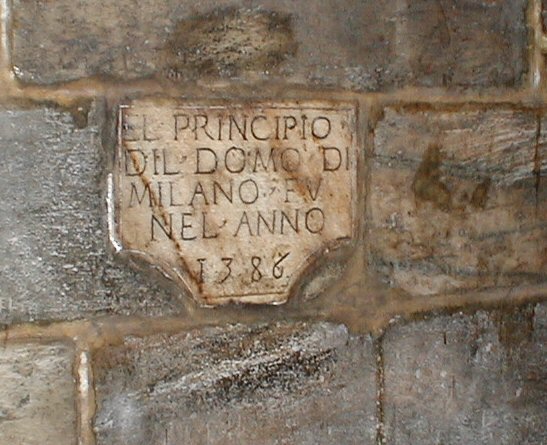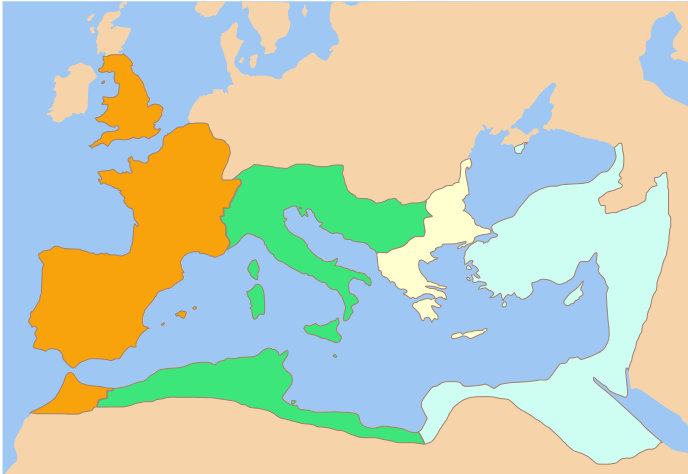|
St Thecla's Cathedral
Basilica di Santa Tecla was a former, paleo-Christian basilica church in Milan, region of Lombardy, Italy. It was originally established in 350 and demolished in 1458. Remnants of the structure have been excavated underneath the Milan Cathedral. According to a number of historians the construction of the Basilica was ordered by Roman Emperor Constans in 345 under the name ''Basilica Maior. ''It was then founded in 350.Fiorio, Maria Teresa. ''Le Chiese di Milano''. Milano, Mondadori Electa, 2006. See also * Early Christian churches in Milan References Tecla Tecla is a female given name. Notable people with the name include: * Tecla Insolia (born 2004), Italian actress and singer * Tecla Marinescu (born 1960), Romanian sprint canoer * Tecla Namachanja Wanjala (born 1962), Kenyan peace activist * Tec ... 345 establishments 4th-century churches 4th-century establishments in Italy {{Italy-church-stub ... [...More Info...] [...Related Items...] OR: [Wikipedia] [Google] [Baidu] |
Basilica Di Santa Tecla Milano 5
In Ancient Roman architecture, a basilica is a large public building with multiple functions, typically built alongside the town's forum. The basilica was in the Latin West equivalent to a stoa in the Greek East. The building gave its name to the architectural form of the basilica. Originally, a basilica was an ancient Roman public building, where courts were held, as well as serving other official and public functions. Basilicas are typically rectangular buildings with a central nave flanked by two or more longitudinal aisles, with the roof at two levels, being higher in the centre over the nave to admit a clerestory and lower over the side-aisles. An apse at one end, or less frequently at both ends or on the side, usually contained the raised tribunal occupied by the Roman magistrates. The basilica was centrally located in every Roman town, usually adjacent to the forum and often opposite a temple in imperial-era forums. Basilicas were also built in private residences an ... [...More Info...] [...Related Items...] OR: [Wikipedia] [Google] [Baidu] |
Milan
Milan ( , , Lombard: ; it, Milano ) is a city in northern Italy, capital of Lombardy, and the second-most populous city proper in Italy after Rome. The city proper has a population of about 1.4 million, while its metropolitan city has 3.26 million inhabitants. Its continuously built-up urban area (whose outer suburbs extend well beyond the boundaries of the administrative metropolitan city and even stretch into the nearby country of Switzerland) is the fourth largest in the EU with 5.27 million inhabitants. According to national sources, the population within the wider Milan metropolitan area (also known as Greater Milan), is estimated between 8.2 million and 12.5 million making it by far the largest metropolitan area in Italy and one of the largest in the EU.* * * * Milan is considered a leading alpha global city, with strengths in the fields of art, chemicals, commerce, design, education, entertainment, fashion, finance, healthcar ... [...More Info...] [...Related Items...] OR: [Wikipedia] [Google] [Baidu] |
Italy
Italy ( it, Italia ), officially the Italian Republic, ) or the Republic of Italy, is a country in Southern Europe. It is located in the middle of the Mediterranean Sea, and its territory largely coincides with the homonymous geographical region. Italy is also considered part of Western Europe, and shares land borders with France, Switzerland, Austria, Slovenia and the enclaved microstates of Vatican City and San Marino. It has a territorial exclave in Switzerland, Campione. Italy covers an area of , with a population of over 60 million. It is the third-most populous member state of the European Union, the sixth-most populous country in Europe, and the tenth-largest country in the continent by land area. Italy's capital and largest city is Rome. Italy was the native place of many civilizations such as the Italic peoples and the Etruscans, while due to its central geographic location in Southern Europe and the Mediterranean, the country has also historically been home ... [...More Info...] [...Related Items...] OR: [Wikipedia] [Google] [Baidu] |
Milan Cathedral
Milan Cathedral ( it, Duomo di Milano ; lmo, Domm de Milan ), or Metropolitan Cathedral-Basilica of the Nativity of Saint Mary ( it, Basilica cattedrale metropolitana di Santa Maria Nascente, links=no), is the cathedral church of Milan, Lombardy, Italy. Dedicated to the Nativity of St Mary (''Santa Maria Nascente''), it is the seat of the Archbishop of Milan, currently Archbishop Mario Delpini. The cathedral took nearly six centuries to complete: construction began in 1386, and the final details were completed in 1965. It is the largest church in the Italian Republic—the larger St. Peter's Basilica is in the State of Vatican City, a sovereign state—and possibly the second largest in Europe and the third largest in the world (its size and position remain a matter of debate). History Milan's layout, with streets either radiating from the Duomo or circling it, reveals that the Duomo occupies what was the most central site in Roman Mediolanum, that of the public bas ... [...More Info...] [...Related Items...] OR: [Wikipedia] [Google] [Baidu] |
Constans
Flavius Julius Constans ( 323 – 350), sometimes called Constans I, was Roman emperor from 337 to 350. He held the imperial rank of ''caesar'' from 333, and was the youngest son of Constantine the Great. After his father's death, he was made ''augustus'' alongside his brothers in September 337. Constans was given the administration of the praetorian prefectures of Italy, Illyricum, and Africa. He defeated the Sarmatians in a campaign shortly afterwards. Quarrels over the sharing of power led to a civil war with his eldest brother and co-emperor Constantine II, who invaded Italy in 340 and was killed in battle with Constans's forces near Aquileia. Constans gained from him the praetorian prefecture of Gaul. Thereafter there were tensions with his remaining brother and co-''augustus'' Constantius II (), including over the exiled bishop Athanasius of Alexandria. In the following years he campaigned against the Franks, and in 343 he visited Roman Britain, the last legitimate emp ... [...More Info...] [...Related Items...] OR: [Wikipedia] [Google] [Baidu] |
Early Christian Churches In Milan
Early Christian churches in Milan are the first churches built immediately after the Edict of Milan (Edictum Mediolanense) in February 313, issued by Constantine the Great and Licinius, which granted tolerance and religious liberty to Christianity within the Roman Empire. Historical and artistic context Ever since the fall of the Severan dynasty, which ruled the Roman Empire between 193 and 235, rivals for the imperial throne had bid for support by either favouring or persecuting Christians. During the following period known as the crisis of the Third Century (AD 235–284) the Roman Empire nearly collapsed under the combined pressures of invasion, civil war, plague, and economic depression. The Crisis began with the assassination of Emperor Alexander Severus at the hands of his own troops, initiating a fifty-year period in which 20–25 claimants to the title of Emperor, mostly prominent Roman army generals, assumed imperial power over all or part of the Empire. During the Ci ... [...More Info...] [...Related Items...] OR: [Wikipedia] [Google] [Baidu] |
Basilica Churches In Milan
In Ancient Roman architecture, a basilica is a large public building with multiple functions, typically built alongside the town's forum. The basilica was in the Latin West equivalent to a stoa in the Greek East. The building gave its name to the architectural form of the basilica. Originally, a basilica was an ancient Roman public building, where courts were held, as well as serving other official and public functions. Basilicas are typically rectangular buildings with a central nave flanked by two or more longitudinal aisles, with the roof at two levels, being higher in the centre over the nave to admit a clerestory and lower over the side-aisles. An apse at one end, or less frequently at both ends or on the side, usually contained the raised tribunal occupied by the Roman magistrates. The basilica was centrally located in every Roman town, usually adjacent to the forum and often opposite a temple in imperial-era forums. Basilicas were also built in private residences and ... [...More Info...] [...Related Items...] OR: [Wikipedia] [Google] [Baidu] |
345 Establishments
The Year 345 ( CCCXLV) was a common year starting on Tuesday (link will display the full calendar) of the Julian calendar. At the time, it was known as the Year of the Consulship of Amantius and Albinus (or, less frequently, year 1098 '' Ab urbe condita''). The denomination 345 for this year has been used ever since the early medieval period, when the Anno Domini calendar era became the prevalent method in Europe for naming years. Events By place India * Merchant Knai Thomman and 400 followers visit the Malabar Coast in Kerala (India), and assist the church there. * The Kadamba Dynasty is founded by Mayurasharma. Italy * Constans orders the Basilica di Santa Tecla to be constructed in Lombardy. Births * Evagrius Ponticus, Christian monk and ascetic (d. 399) * Afranius Syagrius, Roman politician and administrator * Quintus Aurelius Symmachus, Roman consul and intellectual (d. 402) * Tyrannius of Aquileia, historian and theologian (approximate date) Deaths ... [...More Info...] [...Related Items...] OR: [Wikipedia] [Google] [Baidu] |
4th-century Churches
The 4th century (per the Julian calendar and Anno Domini/Common era) was the time period which lasted from 301 ( CCCI) through 400 ( CD). In the West, the early part of the century was shaped by Constantine the Great, who became the first Roman emperor to adopt Christianity. Gaining sole reign of the empire, he is also noted for re-establishing a single imperial capital, choosing the site of ancient Byzantium in 330 (over the current capitals, which had effectively been changed by Diocletian's reforms to Milan in the West, and Nicomedeia in the East) to build the city soon called Nova Roma (New Rome); it was later renamed Constantinople in his honor. The last emperor to control both the eastern and western halves of the empire was Theodosius I. As the century progressed after his death, it became increasingly apparent that the empire had changed in many ways since the time of Augustus. The two emperor system originally established by Diocletian in the previous century fell i ... [...More Info...] [...Related Items...] OR: [Wikipedia] [Google] [Baidu] |







